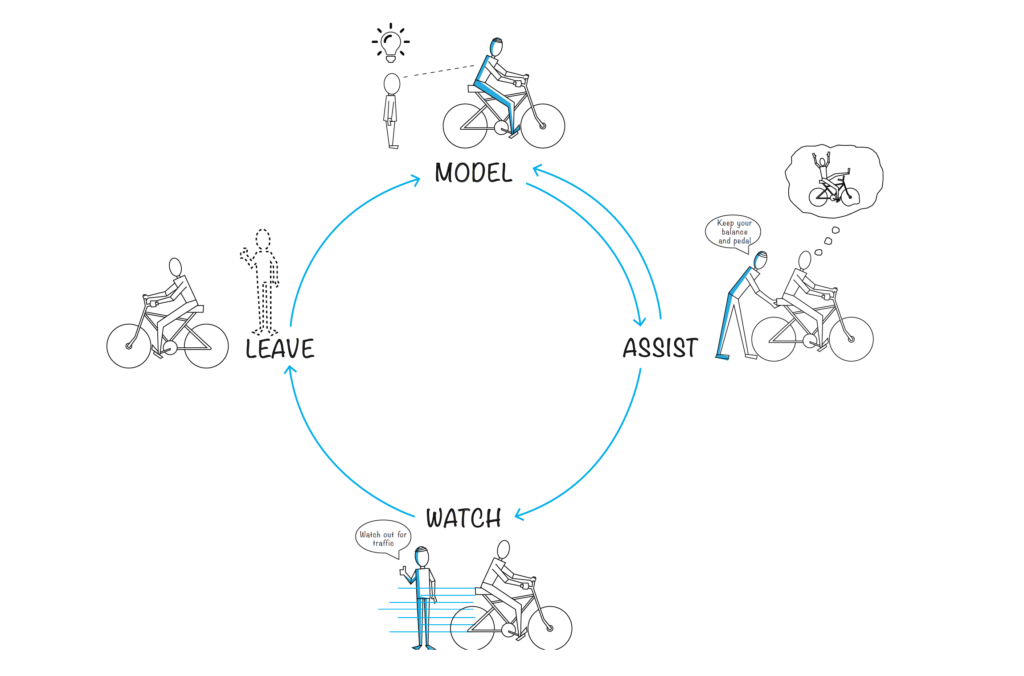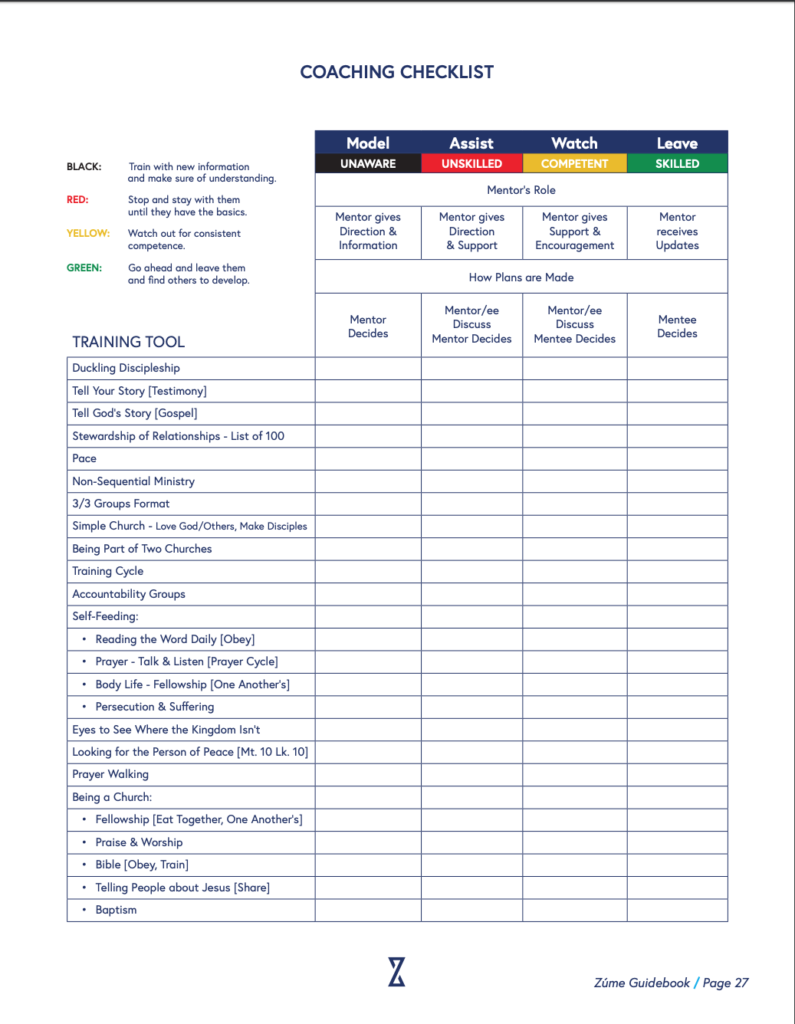As we think about multiplying disciples, it’s helpful if we bear in mind the training cycle. The training cycle is: model, assist, watch, and leave.
I like to compare this to the process of a parent teaching a child to ride a bicycle.

Model
So the first step of this process, though we don’t often think about it, is for the child to see someone else riding a bicycle. Maybe they see a neighbor kid and they say, “When I get big, I want to ride a two-wheeler, just like Johnny.” That step only takes a moment, but it’s an essential step for all of us.
So all of us — we saw someone ride a bicycle and that put the concept in our mind. This has been true for everyone except for the person who invented the bicycle — it just takes a moment.
Assist
The second step is a bit longer. It’s what is called the assist phase. So in the assist phase, of course you can use training wheels to assist, but sort of the international time-honored classic is the parent holding on to the bicycle — maybe left hand on the handlebars, right hand under the seat — and the parent walks along beside the child.
You know they say, “Keep pedaling honey! Yeah! Go faster. Don’t lean on me.” And they’re walking along beside the bicycle. Then they can say, “Okay, I can tell you’ve just about got it. All right, I’m gonna let go … ready … 1, 2 and they let go on 3.”
Usually what happens? Crash. Right? Usually the child falls down maybe gets skinned up a bit.
When that happens, we don’t say, “Oh, too bad. I guess you’re just not meant to ride a bicycle. Maybe your brother will be able to.” Something like that. No, we put them back on the bicycle immediately, and we get up to speed again, and we let go. They may fall two or three or four times, but eventually they get to the point where they can stay up. That was the assist phase.
Watch
Then comes the watch phase. Now this is the longest phase so far. The watch phase means that we need to continue to watch the child until they’ve mastered the skills necessary for them to ride safely on their own, whenever and wherever they want to. There are lots of skills they have to master.
They have to be able to pick the bicycle up if they fall, get on it. They need to be able to start from a stop. They need to master steering so that they can handle curves. They need to master braking, controlling the speed of the bicycle. They need to know how to go up hills and down hills safely. They need to understand the rules of the road — where it’s safe to ride, where it isn’t safe to ride. There are all of these things have to be mastered before they can safely be allowed to ride when they want, where they want.
Leave
Once those skills are mastered however, it’s perfectly appropriate for the parent to leave. If the child can only ride their bicycle when their parent is there, they will not ride their bicycle nearly as much as if when the parent is not required to be there.
Nobody wants constant supervision, if they’ve already mastered the skills. It would be crazy for me to call up my dad to ask him to come watch me ride a bicycle. I know how to ride a bicycle. I’ve taught other people how to ride a bicycle. I don’t need him to watch me, right? So eventually there comes a time when it’s appropriate to leave. There’s a parallel process in making disciples and in starting new churches, where we model, we assist, we watch … and then we leave.

disciple making movement training
online, free @ Zúme.Training
Applied to Disciple-Making
So in church planting, what might this process look like? Well, the model is us just doing the skill in front of the person that we’re mentoring … that just takes a moment. One time is usually sufficient.
Then we assist, they need to get on the bicycle right. It’s like the illustration I gave earlier about not being able to learn how to ride a bike just by watching the Tour de France. In the assist phase, they need to do the skill and you’re just there to observe and make suggestions. They don’t know what they’re doing at all, so it requires close contact, close supervision, you need to be directive in this process but they need to be doing it.
Once they’ve got the basics down, then you can back off and be less hands-on in approach, less directive, more simply making sure that they refine the skills and that they have all the skills necessary, but not requiring the close supervision. So this is the watch phase, when you’re doing that.
Then back to the assist phase, I sometimes call that shadow mentoring or shadow pastoring. Meaning, you’re really providing the leadership, but you’re doing it from the background. You’re not up front, they are up front. They are in the spotlight. You are in the shadows providing direction.
Then you back out farther for that watch phase, and they have more responsibility for how much help they’re directing the direction of their development. So once the basic skills are all in place and they feel confident in doing it and in teaching it to others, then you can leave. And again, that’s perfectly appropriate.
Training Cycle with Paul
So what did this process look like for example with the Apostle Paul?
I would suggest to you that Paul was modeling and assisting when he was with a church on the first missionary journey, or while he was in that city he was modeling and assisting. Then when he left, he entered the watch phase.
So for the modeling and assisting, other than Corinth or Ephesus, the total time in any place would have been less than six months — in Corinth and Ephesus a bit longer — but then he would watch for an extended period of time — over a decade. And during that time he might come back for a repeat visit. He might send a co-worker to be with them. He would write a letter to them — that he’s staying in touch, making sure that they’re picking up what they need, but eventually he leaves.
We see this most clearly with Ephesus. You remember he was on his way back to Jerusalem and was passing nearby Ephesus and he summoned the elders of the Ephesian church to come meet with him. He told them, “You will never see my face again. I’ve told you everything that you need. I need to go on to other places.” Now this was sad for them. It says they wept greatly because of the word that they would not see his face again.
Now Paul was not under the illusion that nothing would go wrong. He knew there would be problems. He told them there will be false teachers arise even from among you, but you’ve got everything you need. So he knew there would be problems but that they had been equipped to deal with those problems … so he was leaving them … no more contact.
So this is what the process looked like with the Apostle Paul.
Watch to the 4th Generation
Now the last thing, in a sense, that can be checked off this list of necessary skills is mastering the training cycle itself. In order to make sure that that has happened, you need to watch to at least the fourth generation.
So for example the first generation models for the second generation. Then the first generation assists the second generation to model for the third generation. Then the first generation watches the second generation assist the third generation model for the fourth generation. And then once you’ve seen it — that fourth generation — you can be confident that that second generation is successfully performing the training cycle for subsequent generations.
So, each phase can advance whenever you’re seeing multiplication to the next generation, but you need to watch all the way through the training cycle, so that the whole package is in place.
MAWL Each Skill Individually
From a practical perspective, when I’m mentoring someone, I have a list of concepts and skills that I want to make sure they master, and so literally I will check off as they advance through their ability to not only do it well but to pass it on to others. Once they finish the list and I’m seeing that happen to the fourth generation, then I’m confident that I can leave. So this is the training cycle.
We’re in a phase with someone for each skill. For example maybe the person that I’m mentoring fully understands the concept of the spiritual economy and they’re living that out and they’re passing that along, but when it comes to understanding duckling discipleship, they aren’t that comfortable with that yet. They aren’t practically applying that in the way that they are discipling others. They’re holding them back from ministering, from not only applying, but sharing with others what they’ve learned.
So in regard to the spiritual economy maybe, I’m in the watch or even the leave phase, but in regard to the duckling discipleship idea, I still need to assist them, I still need to be somewhat directive.
Ultimately, I need to work through the training cycle for all of the different aspects, the different skills, the different concepts that are necessary, before I leave them completely.
Coaching Checklist Example

Zúme is a community of practice
for those who want to see
disciple making movements.
More Multiplication Concepts
This concept is part of the “Multiplication Concepts” series by Curtis Sergeant. Consider working through the entire series and challenging someone you know to do it with you. See an entire list of the concepts in the article titled “Multiplication Concepts”.
This same concept is taught in the Zúme Training course using video animation and is translated into 40 languages. The concepts in this lesson can be found in “Coaching Checklist” and “Training Cycle”.
Zúme Training is an on-line and in-life learning experience designed for small groups who follow Jesus to learn how to obey His Great Commission and make disciples who multiply.
